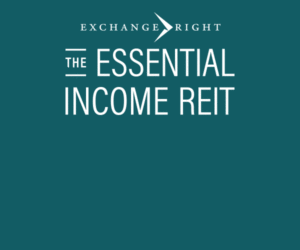The Challenges of Calculating Nontraded REIT Investor Rates of Return
February 19, 2018 | James Sprow | Blue Vault
With the recent release of the 5th Edition Blue Vault Nontraded REIT Full-Cycle Performance Study, this may be an appropriate time to offer perspectives on the challenges faced when calculating rates of return by investors in nontraded REIT programs.
With most investments, the calculation of an annualized rate of return is relatively simple. For example, for a listed common stock, an Excel formula (=XIRR [Values, Dates]) allows the analyst to input each cash flow such as the price paid, the dividends received, the price received when sold or the current market price, and the dates for each cash flow. The formula then calculates the annualized rate of return, using the cash flows and the exact dates when each occurred. Reports on the performance of listed stocks and bonds are readily available on such sites as Yahoo Finance, and the metrics found there include rates of return, current yields, and historical pricing.
Nontraded REIT programs present a unique challenge. First, because they are illiquid investments, an investor’s rate of return cannot be measured until the investment is liquidated through a listing, a merger with a listed company, or a portfolio liquidation resulting in special distributions. In many cases, the full-cycle event does not occur all at one time, but rather the liquidating distributions occur over time until the shareholder’s equity in the REIT is reduced to zero.
To estimate an investor’s annualized rate of return, several assumptions are required. First, since a typical nontraded REIT public offering extends over at least two or more years, a simplified analysis of returns requires an assumption about when the initial investment was made. In Blue Vault’s Full-Cycle studies, we use the first quarter of the public offering, the middle quarter of the offering, and the last quarter of the offering to calculate hypothetical returns for early, middle, and late investors. Historically, only a few REITs have had different offering prices during the public offering, but a lower price initially (e.g., shares of Apple Hospitality[G1] REITs that were initially offered at $10.50, then were raised to $11.00) can raise the rate of return calculated for early investors relative to middle and late investors. If a majority of offering proceeds occur later in the offering period, the average returns to middle and late investors may be cited as more “typical” for the REIT, but even in an offering that extends for two years, eight different returns can be calculated for the eight different quarters when initial investments could have been made.
A second unique feature of nontraded REIT offerings is the option shareholders have to reinvest distributions via a DRIP (Distribution Reinvestment Program). These reinvestments are typically at a discounted price compared to the original offering price ($9.50 vs. $10.00). If an investor participates in the DRIP, the rate of return for that investor will differ when compared to those who did not reinvest. Interestingly, those who reinvest distributions will normally have a higher average rate of return due to the discounted price for DRIP shares if the REIT eventually has a capital gain at the full-cycle event. However, those who reinvest via the DRIP can have a lower average rate of return if the REIT has a capital loss (full-cycle proceeds are lower than the original share price).
Another complicating factor in calculating returns is the timing of distributions. Most nontraded REITs pay distributions each quarter, although most do not begin paying distributions in the first quarter of their offering, and many suspend distributions near the full-cycle date. Since some REITs have paid distributions monthly rather than quarterly, and the actual payment dates differ from one REIT to the next in the sample of full-cycle REITs, a simplifying assumption must be made as to the timing of distributions. Blue Vault assumes that distributions are received at the end of the quarter in which they were paid. This assumption is consistent with the assumption that initial investments occur at the end of each offering quarter.
Since the first Blue Vault Nontraded REIT Full-Cycle Performance Study was published in 2012, a unique contribution to our understanding of nontraded REIT performance has been the use of custom benchmarks. In that study, completed with the assistance of Dr. Jay Hartzell at the University of Texas, Blue Vault researchers compiled detailed data on the portfolios of the nontraded REITs that had completed full-cycle events. The data included the property types and the locations of all properties in the portfolios for each year of the REIT’s life. We then used the detailed portfolio data to calculate custom benchmarks by comparing the returns of the nontraded REITs to returns on hypothetical portfolios of both private (NCREIF) portfolios and public (FTSE-NAREIT) portfolios, matched by type and location. We have used these custom benchmarks in each edition of the study since 2012.
One critical factor in making apples-to-apples comparisons of returns is the use of leverage. Whenever a REIT uses borrowings to finance its asset portfolios, shareholders potentially benefit and have higher rates of return to the extent that the returns on the REIT’s assets exceed its cost of borrowing. When comparing two property portfolios of similar composition (weighted averages by property types and geographic locations), it is necessary to account for the degree to which debt financing has been used to leverage shareholder returns. For example, the NCREIF indexes for returns on different types of real estate in different regions of the U.S. are all compiled from appraisal-based property values and quarterly income, with no impacts from leverage. The publicly traded index for REITs published by NAREIT includes leveraged traded REITs. To adjust the nontraded REIT returns to make apples-to-apples comparisons to the custom benchmark returns, Blue Vault adjusted the benchmark returns for the effects of leverage that matched the actual leverage utilized by the nontraded REIT.
The use of leverage magnifies the returns to shareholders and increases the risk inherent in those returns, since the interest on debt and the repayment of debt principal always takes priority over returns to shareholders. When assets perform well and appreciate in value, the returns on those assets more than compensate for the use of debt to finance them, and the excess return above the cost of debt financing accrues to shareholders. The downside risk increases in cases where the return on the REIT’s portfolio is lower than its cost of debt, and the difference negatively impacts the shareholder returns.
Using custom benchmarks to compare nontraded REIT returns over a given life or holding period allows Blue Vault to evaluate whether the nontraded REIT performed relatively well or poorly compared to both institutional asset portfolios and traded REIT portfolios, adjusted for differences in leverage.
In differing market environments, REITs will have different rates of return as a result of differences in their portfolios and differing degrees of leverage. One REIT may have a high rate of return in a favorable market environment and perform poorly relative to its custom benchmarks, while a second REIT has a lower rate of return but performs well in relation to its custom benchmarks. To make more nuanced objective comparisons of REIT returns, it is only fair to consider the market environment, the mix of real estate assets, and the use of leverage when evaluating performance.












